Yaki Udon (焼きうどん) is a Japanese udon noodles stir-fried with your choice of protein and vegetables. Protein can be thinly sliced meat or any seafood suitable for stir-fry. This is a very quick and simple udon recipe but so delicious.
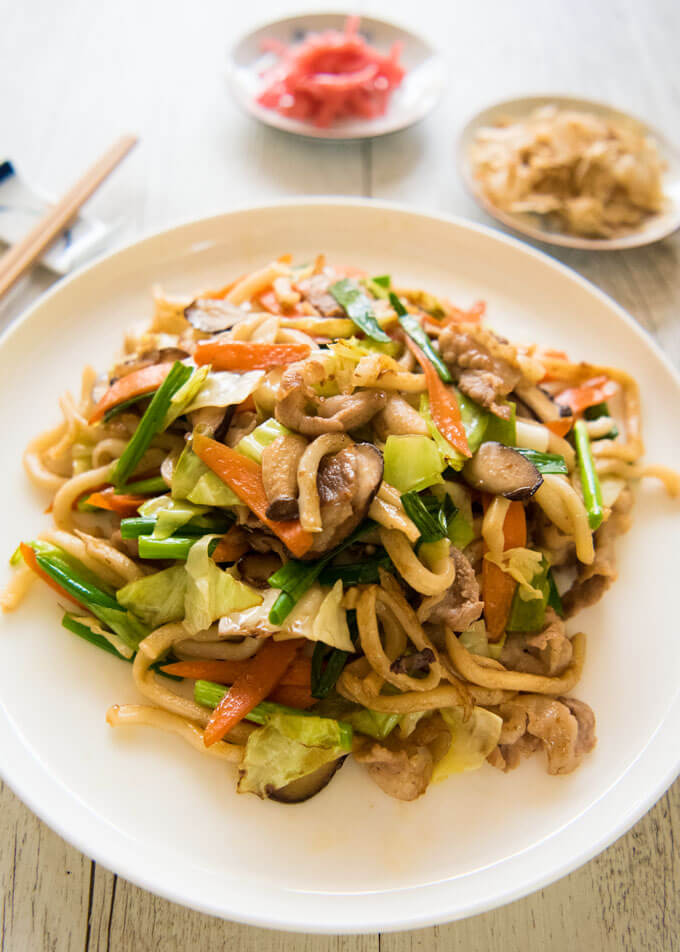
Yaki Udon is similar to Yakisoba but the noodles are udon. You can say that the dish becomes Yaki Udon if you make Yakisoba with udon noodles instead of egg noodles. But there are also a couple of differences.
Firstly, the flavour can either be sauce flavour like Yakisoba or soy sauce flavour. Secondly, it is almost a ‘must’ to top Yaki Udon with a plenty of bonito flakes.
My Yaki Udon has a soy-based flavour with plenty of bonito flakes on top. This gives so much umami to the stir-fried udon noodles and takes the flavour to the next level.
What’s in My Yaki Udon
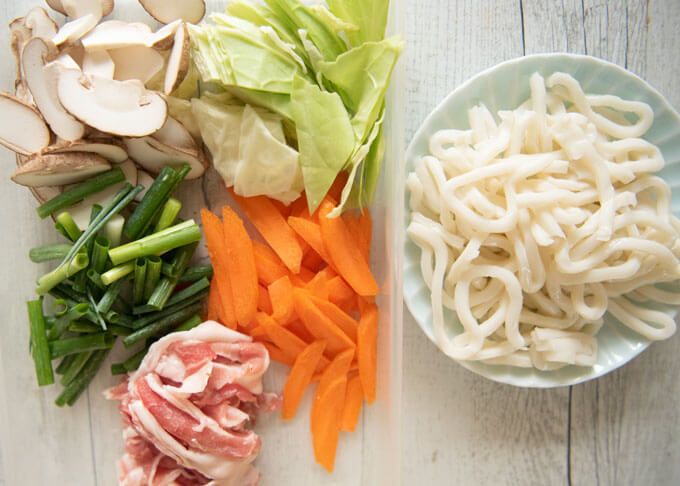
I made two different Yaki Udon dishes using pork slices and prawns. In both dishes, I used the same combinations of vegetables. They are:
- Cabbage – cut into large bit-size pieces
- Carrot – thinly sliced
- Shallots/scallions – cut into 5cm/2” long pieces
- Shiitake mushrooms – sliced thinly
Instead of/in addition to the above, you can consider the following vegetables:
- Onion
- Bean sprouts
- Capsicum – any colour
- Asian mushrooms such as shimeji, King oyster, enoki, oyster.
You can stir-fry almost any meat/seafood and vegetables with the udon noodles as long as they are suited for stir-fry, however, in Japan beef is not often used in Yaki Udon.
About the Flavouring Sauce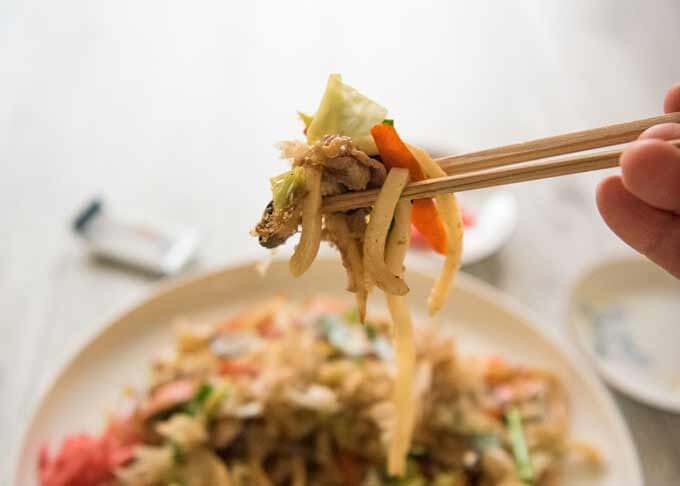
My sauce is quite simple. It is a mixture of soy sauce, sake, mirin and sesame oil. Blow are the qantities of each ingredient for 2 servings:
Soy Sauce: 2½ Tbsp
Sake: 2½ Tbsp
Mirin: 1 Tsp
Sesame Oil: 1 Tbsp
Just mix them and pour the sauce over the stir-fried udon noodles at the end.
As I mentioned earlier, you can use the same sauce as yakisoba sauce. But I think that the sauce in my Yakisoba recipe is a bit too heavy for Yaki Udon. If you prefer the yakisoba-style sauce to my soy-based flavouring, I would recommend using Worcestershire sauce instead. It is not as thick as my Yakisoba sauce and it’s not sweet either.
How to Make Yaki Udon
The method of making Yaki Udon is very similar to that of Yakisoba. Well, actually, it’s almost the same except that the sauce is different.
- Mix the flavouring sauce
- Stir-fry the pork slices/seafood pieces
- Add the vegetables and stir-fry
- Add the udon noodles and stir-fry
- Pour the sauce and mix
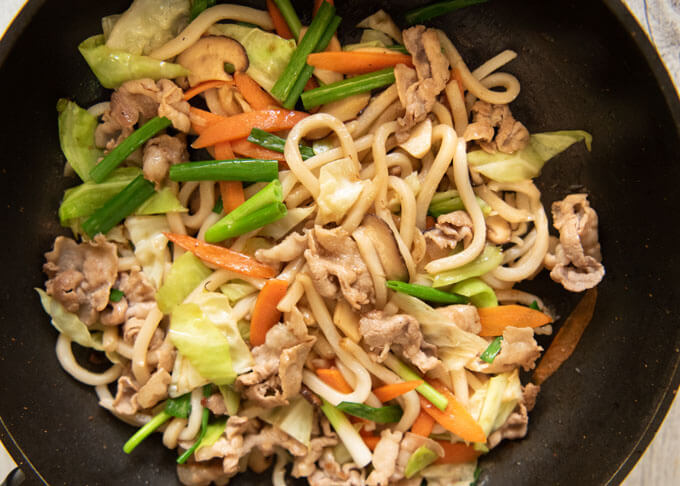
Here are some notes to help you to make a perfect Yaki Udon:
- If you are using seafood instead of meat, put aside the cooked seafood while stir-frying the vegetables. Then put them back in at the same time as the udon noodles.
- When cooking the vegetables, stagger the addition of the vegetables by starting with the vegetable that takes longest time to cook. In this way, all the vegetables will be cooked just right at the same time.
- Quickly rinse the udon noodles under running water to untangle the strands before stir-frying. Fresh undon noodles are usually vacuum sealed in a plastic bag. They are stuck together and hard to untangle while stir-frying.
- If the udon noodles are straight from the fridge, use hot water to warm them up to rinse. Cold udon noodles take time to warm up while stir-frying, and the other ingredients get overcooked.
Toppings
What makes today’s noodle dish so tasty is a generous amount of katsuobushi (鰹節, bonito flakes). It is also called ‘kezuribushi’ (削り節).
Bonito flakes add umami to the dish and make the noodles so flavoursome. In my view, bonito flakes are a ‘must’ for Yaki Udon.
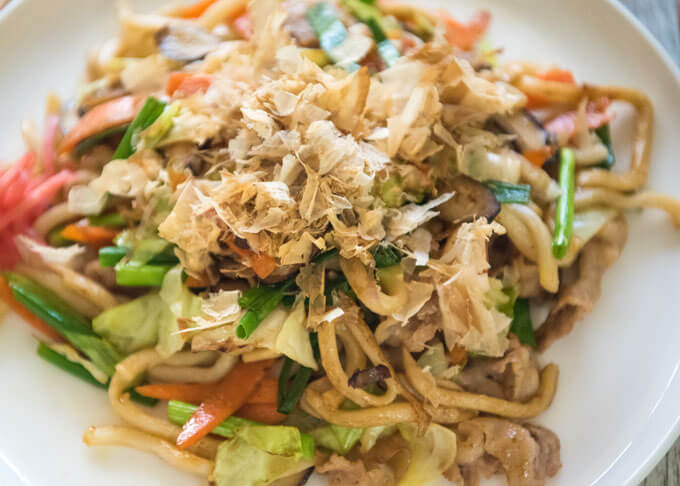
Another common topping is a red pickled ginger called ‘benishōga’ (紅生姜). You can find more details about benishōga and a photo in my post Yakisoba. You only need a small amount of benishōga. It can be placed on top of the pile of the Stir-fried Udon Noodles or on the side.
In the recipe, I included the ingredients and instructions to make either Pork Yaki Udon or Prawn Yaki Udon. The only differences are the choice of protein, i.e. pork slices or prawns, and the way the prawns are stir-fried with other ingredients.
Here is the photo of Prawn Yaki Udon. I split the prawns in half as whole prawns were too large for Yaki Udon. Split prawn meat twisted and curled when cooked and I thought it was fancy.
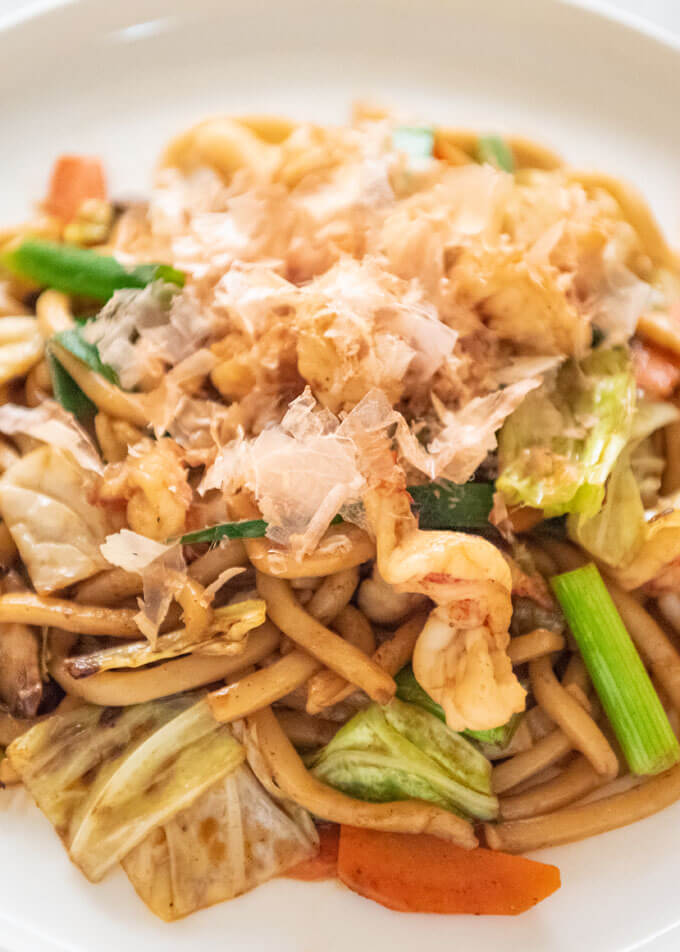
Perhaps because of the difference in flavouring, Yaki Udon tastes lighter than Yakisoba and a little bit more authentic.
I hope you try this tasty noodle dish!
Yumiko![]()
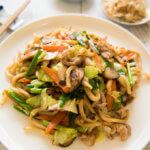
Yaki Udon (焼きうどん) is a Japanese undon noodles stir-fried with your choice of protein and vegetables. Your protein can be thinly sliced meat or any seafood suitable for stir-frying. This is a very quick and simple udon recipe and so delicious.
The recipe is written to make either Pork Yaki Udon or Prawn Yaki Udon. The only differences are the choice of protein, i.e. pork slices or prawns, and the way the prawns are stir-fried with other ingredients.
Don't forget to see the section 'MEAL IDEAS' below the recipe card! It gives you a list of dishes that I have already posted and this recipe that can make up a complete meal. I hope it is of help to you.
- 2 servings udon noodles (360g/0.8lb, note 1)
- 200g/7oz pork , thinly sliced into bite size pieces (note 2)
- 200g/7oz fresh prawns (small to medium size) , peeled and deveined
- 100g/3.5oz cabbage , cut into large bite size pieces
- 60g/2.1oz carrot , thinly sliced diagonally (note 3)
- 25g/0.9oz each shiitake and king oyster mushrooms , thinly sliced (note 4)
- 2 stalks shallots/scallions , cut to 5cm/2" long
- 1 tbsp oil
- ½ tbsp sesame oil
- 2.5 tbsp soy sauce
- 2.5 tbsp cooking sake
- 1 tsp mirin
- 1 tbsp sesame oil
- 6g/0.2oz bonito flakes (note 5)
- 1 tbsp benishōga (pickled red ginger) (optional)
-
Add all the Flavouring Sauce ingredients into a measuring cup or a small bowl and mix well. Set aside until required.
-
Transfer the udon noodles to a sieve and untangle noodles quickly under running water. Drain.
-
Heat oil and sesame oil in a wok or a large frying pan over medium high heat.
-
If making Pork Yaki Udon, add the pork slices to the frying pan and sauté until the pork is almost cooked through (less than a minute if very thin, about 1-2 minutes if thicker).
-
If making Prawn Yaki Udon, add the prawns to the frying pan and sauté until the prawns curl up to form a 'C' shape and the surface starts browning a little bit (about a minute). Put the prawns aside on a plate. Add a bit more ooil to the frying pan if too dry.
-
Add the carrots to the frying pan and stir-fry for 30 seconds, then add the cabbage and the mushrooms. Stir-fry for about 1 minute until the cabbage is half cooked, then add the shallots.
-
After mixing the shallots with the meat and vegetables, add the noodles and prawns, including the juice (if making Prawn Yaki Udon). Stir-fry, mixing all the ingredients well until some noodles start browning a little bit.
-
Add the Flavouring Sauce mixture and mix quickly to ensure that all the noodles are coated with the sauce and the sauce has almost evaporated. Turn the heat off.
-
Transfer the noodles onto serving plates, pile it into a mound, and topped with bonito flakes. Put the benishōga on the top or the side of the noodles, if using.
-
Serve immediately.
1. I used 2 packs of fresh cooked udon noodles that I bought from an Asian grocery store. They were slightly more expensive than those you find in supermarkets, but the quality of noodles is better. They do not easily break into short pieces when stir fried.
If your fresh noodles are uncooked, boil them to al dente and rinse well under running water to remove sliminess. The noodles will also be firmed up.
Instead of using fresh udon noodles, you can cook dried udon noodles and use them. The dried udon noodles are much thinner than the fresh ones in general so the Yaki Udon will look a bit different from my photos.
2. I used very thinly sliced pork belly strips that I cut to short bite-size strips. But you can of course use sliced pork with less fat.
3. If the carrot is thick, halve it vertically, then slice diagonally.
4. You can also use other Asian mushrooms such as shimeji mushrooms, enoki mushrooms, or pearl mushrooms. They are better suited to this dish than button mushrooms or swiss mushrooms.
5. A small pack usually contains 3g of bonito flakes which means 1 pack per serving.
6. Nutrition per serving.
serving: 489g calories: 618kcal fat: 33g (51%) saturated fat: 7.4g (37%) trans fat: 0.1g polyunsaturated fat: 7.4g monounsaturated fat: 16g cholesterol: 72mg (24%) sodium: 1411mg (59%) potassium: 970mg (28%) carbohydrates: 45g (15%) dietary fibre: 5.4g (22%) sugar: 9g protein: 30g vitamin a: 102% vitamin c: 40% calcium: 6.9% iron: 19%
Meal Ideas
A typical Japanese meal consists of a main dish, a couple of side dishes, a soup and rice. I try to come up with a combination of dishes with a variety of flavours, colours, textures and make-ahead dishes.
Yaki Udon contains a sufficient amount of carbohydrates so you don’t need a bowl of rice. It also contains quite a bit of vegetables but I added two side vegetable dishes that have different textures and flavours.
If you feel that you need more protein, replace Hijiki Seaweed Salad with something like Squid with Cucumber and Wakame Nuta. Nuta (vinegary miso dressing) brings a totally different flavour to the meal.
- Main: Yaki Udon (Stir-fried Udon Noodles) – today’s recipe.
- Side dish 1: Hijiki Seaweed Salad (Hijiko no Nimono) – make ahead, or Squid with Cucumber and Wakame Nuta if more protein is needed.
- Side dish 2: Daikon Salad with Pickled Plum Dressing – daikon and dressing can be prepared the day before.
- Soup: Miso Soup of your choice from Miso Soup Ingredient Combinations or your favourite ingredients.
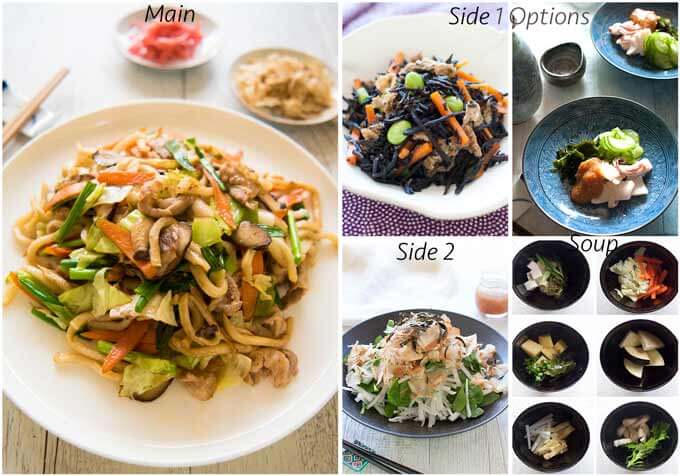
Really nice recipe, I broke the rules a bit and used a steak that needed eaten. I grilled the steak separately and added it just at the very end sliced up with its resting juices and some togarashi shichimi and sesame oil drizzle over first. V nice thanks for the wonderful recipes and instructions. Happy Hogmanay from Glasgow, Scotland x
Happy New Year, Kristy.
It’s ok to change part of the recipe to suit your need. Home-cooking is meant to be flexible and creative. I am glad to hear that you enjoyed the dish.
Hi, can this be cooked ahead and reheated? Thanks
Hi Lynda, yes you can. Enjoy!
Is there anything I can use instead of cooking sake?
Hi Suzy, you can substitute cooking sake with dry sherry or Chinese rice wine. If you cannot take alcohol, you could use broth.
I tried this last night. Very good taste but I did something wrong with the noodles. I got fresh udon noodles. Should I have boiled them first? I did rinse the uncooked noodles but maybe not enough. They clumped together during the stir-fry and felt uncooked. (Thank-you for the wonderful recipes and your very interesting explanations.)
Hi Richard, it sounds like your udon noodles were uncooked fresh noodles, which need pre-boiling. After boiling them, rinse under running water to remove sliminess and firm up the strands. I will add a note to be aware of uncooked fresh noodles vs cooked noodles. Thanks for your comment.
Tried this recipe yesterday and it was reallY tasty. I added some chilli on top as it was lacking a bit of spice for me, but it was still really good and easy to follow. Thank u!
Hi Preetha, great! My hairdresser tried 2 days ago and gave me almost the identical feedback to yours, including adding chilli. What a coincidence!
Where can I purchase ingredients if ordering online? Sauces and udon noodles.
Hi Debbie, if you Google search ‘online Japanese Grocery stores’. It should list quite few online shops and most of them should sell ingredients used in this recipe.
Hi Yumiko I will try your sauter, i found in Canada,Québec , a draft sake ,( DAIGINJO unpasteurized and undiluted Sake 200ml size bottle good for about 5 sautes) this stuf is ok!!!, and I would like to know if I change soya sauce because to mutch salt in ordinairy soya sauce ,for BRAGG soya sauce will do the same.??? (to mutch salt I will be big like a balloon) thanks
Hi Sylvain, yes, you can use GRAGG soya sauce instead of soy sauce. Daiginjo sake sounds great!
Thanks for posting these cool recipes! I just recently found your website and feel so inspired to explore Japanese food!
Hi Daniel, welcome to RecipeTin Japan! Please try all sorts of recipes and let me know what you think.
Hello. I made this dish tonight and the flavor was lovely. However, my noodles never browned; instead, they stewed and became somewhat mushy. Do you have any tips about how to brown your noodle dishes.
Hi Heather, the only thing I can think of is too much moisture in your udon noodles. They were probably not drained enough when added to the frying pan. also, if the vegetables are very wet whey stir-frying, it will make the sauce thin as well.
Thank you!